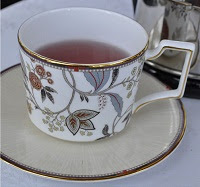High Tea, as a tradition, has humble beginnings. It was traditionally served at around five in the evening at farms all around Britain's countryside. At the end of a long day that began before dawn, farmers and farm workers returned home tired and hungry. Along with cups of strong tea, served with milk and sugar, platters of hearty sandwiches (with meat, cheese, and veggies) and pastries (such as scones, tea cakes, jam rolls, etc.) were also served. An informal meal, it was consumed at the kitchen table, which originally had high stools in lieu of chairs for seating, hence the name "High Tea." This was the main meal of the evening followed up a light supper at eight o'clock.
 As urbanization became more and more the norm, the rituals around high tea also shifted. It became more of a stylish and less hearty meal, more of a fancy tea, and was consumed between three and four o'lock in the afternoon. The dining room with a neatly laid out service—of fine bone china, exquisite linen napkins, crystal stemware, and real silver eating utensils—became de rigueur. Delicate finger food was served with a variety of lightly-brewed teas. Sandwiches and pastries still featured highly on the menu, but the smaller size of the offerings allowed for tiered serving dishes and lace doilies.
As urbanization became more and more the norm, the rituals around high tea also shifted. It became more of a stylish and less hearty meal, more of a fancy tea, and was consumed between three and four o'lock in the afternoon. The dining room with a neatly laid out service—of fine bone china, exquisite linen napkins, crystal stemware, and real silver eating utensils—became de rigueur. Delicate finger food was served with a variety of lightly-brewed teas. Sandwiches and pastries still featured highly on the menu, but the smaller size of the offerings allowed for tiered serving dishes and lace doilies.
Modern High Tea is very popular in the UK as well as in Canada, the United States, New Zealand, and Australia.
 Tea is served with warm milk, sugar, lemon, and honey. Hot water is brought to the table in a ceramic jug along with decorative tins of various tea leaves. First, the teapot is rinsed out with hot water to warm the pot. Tea is spooned in, one for each cup of tea plus one for the pot. Appropriate quantity of hot water is poured in and the teapot's covered with a decorative, quilted tea cozy. The tea's allowed to steep for 5–7 minutes, after which it is carefully strained into each cup.
Tea is served with warm milk, sugar, lemon, and honey. Hot water is brought to the table in a ceramic jug along with decorative tins of various tea leaves. First, the teapot is rinsed out with hot water to warm the pot. Tea is spooned in, one for each cup of tea plus one for the pot. Appropriate quantity of hot water is poured in and the teapot's covered with a decorative, quilted tea cozy. The tea's allowed to steep for 5–7 minutes, after which it is carefully strained into each cup.
Sandwiches have to be cut into neat triangles and the crust removed. Typical fillings, include cream cheese and lox, cucumber and butter, pâté, smoked trout and horseradish, roast beef with mustard and watercress, crab paste with brandy, etc. Mayonnaise and sliced cheese are supposed to be a big no-no.
Scones are served with "fillings" in small bowls, such as fresh clotted cream, lemon curd, jams, and fruit preserves.
Savory pastries, such as mushroom and chevre tarts, florentine quiches, sausage rolls, cheddar bites, etc. are also served.
 The meal's rounded out with sweet pastries, such as jam tarts, mince pies, pecan tartlets, fruit flan, madeleines, raspberry linzers, cheesecakes, lemon bars, shortbread biscuits, custard kisses, sponge cakes, frosted fairy cakes, etc.
The meal's rounded out with sweet pastries, such as jam tarts, mince pies, pecan tartlets, fruit flan, madeleines, raspberry linzers, cheesecakes, lemon bars, shortbread biscuits, custard kisses, sponge cakes, frosted fairy cakes, etc.


 As urbanization became more and more the norm, the rituals around high tea also shifted. It became more of a stylish and less hearty meal, more of a fancy tea, and was consumed between three and four o'lock in the afternoon. The dining room with a neatly laid out service—of fine bone china, exquisite linen napkins, crystal stemware, and real silver eating utensils—became de rigueur. Delicate finger food was served with a variety of lightly-brewed teas. Sandwiches and pastries still featured highly on the menu, but the smaller size of the offerings allowed for tiered serving dishes and lace doilies.
As urbanization became more and more the norm, the rituals around high tea also shifted. It became more of a stylish and less hearty meal, more of a fancy tea, and was consumed between three and four o'lock in the afternoon. The dining room with a neatly laid out service—of fine bone china, exquisite linen napkins, crystal stemware, and real silver eating utensils—became de rigueur. Delicate finger food was served with a variety of lightly-brewed teas. Sandwiches and pastries still featured highly on the menu, but the smaller size of the offerings allowed for tiered serving dishes and lace doilies. Tea is served with warm milk, sugar, lemon, and honey. Hot water is brought to the table in a ceramic jug along with decorative tins of various tea leaves. First, the teapot is rinsed out with hot water to warm the pot. Tea is spooned in, one for each cup of tea plus one for the pot. Appropriate quantity of hot water is poured in and the teapot's covered with a decorative, quilted tea cozy. The tea's allowed to steep for 5–7 minutes, after which it is carefully strained into each cup.
Tea is served with warm milk, sugar, lemon, and honey. Hot water is brought to the table in a ceramic jug along with decorative tins of various tea leaves. First, the teapot is rinsed out with hot water to warm the pot. Tea is spooned in, one for each cup of tea plus one for the pot. Appropriate quantity of hot water is poured in and the teapot's covered with a decorative, quilted tea cozy. The tea's allowed to steep for 5–7 minutes, after which it is carefully strained into each cup. The meal's rounded out with sweet pastries, such as jam tarts, mince pies, pecan tartlets, fruit flan, madeleines, raspberry linzers, cheesecakes, lemon bars, shortbread biscuits, custard kisses, sponge cakes, frosted fairy cakes, etc.
The meal's rounded out with sweet pastries, such as jam tarts, mince pies, pecan tartlets, fruit flan, madeleines, raspberry linzers, cheesecakes, lemon bars, shortbread biscuits, custard kisses, sponge cakes, frosted fairy cakes, etc.

